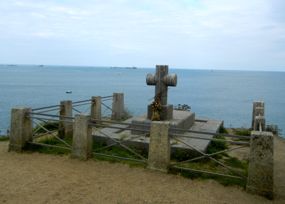 |
Grand Bé, Petit Bé, St-Malo, France | |
| Two small islands off of St-Malo provide interesting visits—but only at low tide! | ||
|
|
|
The 17th century plan was to build a series of forts to protect St-Malo—Le Grand Bé, Le Petit Bé, and the Fort Royal (now called the Fort National) were three of the most significant. The Grand Bé was the smallest and least used. It was largely destroyed during World War II, and was not rebuilt. Today it is best known as the location of the tomb of one of St-Malo's favorite sons, the romantic writer/diplomat/soldier François-René de Chateaubriand. Chateaubriand's tomb is on the seaward side of the island, facing the open water, and a nearby inscription makes his wishes clear: A great French writer wanted to rest here in order to hear only the sea and the wind. Passerby please respect his last wish. You can walk across the sand and a small causeway only at low tide to reach the Grand Bé. Pay careful attention to the tides, which rise quickly, and make sure you don't get caught on the island. The same goes for the Petit Bé, which is even farther out than the Grand Bé and becomes inaccessible even sooner on a rising tide. This small fort and its cannons protected St-Malo from invasion by the English on more than one occasion. In season, you can take a guided tour of the Fort of Le Petit Bé. Check at the Tourist Information Office for times, which vary with the tides. The views from both islands are spectacular. Looking back, you can see the ramparts and the old walled city of St-Malo. Looking out, you see various islands and the beautiful Emerald Coast.
|
|
Above, Tomb of Chateaubriand, on Le Grand Bé, St-Malo. |

